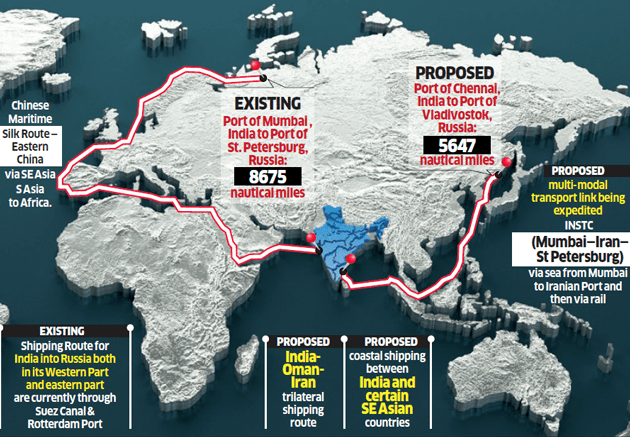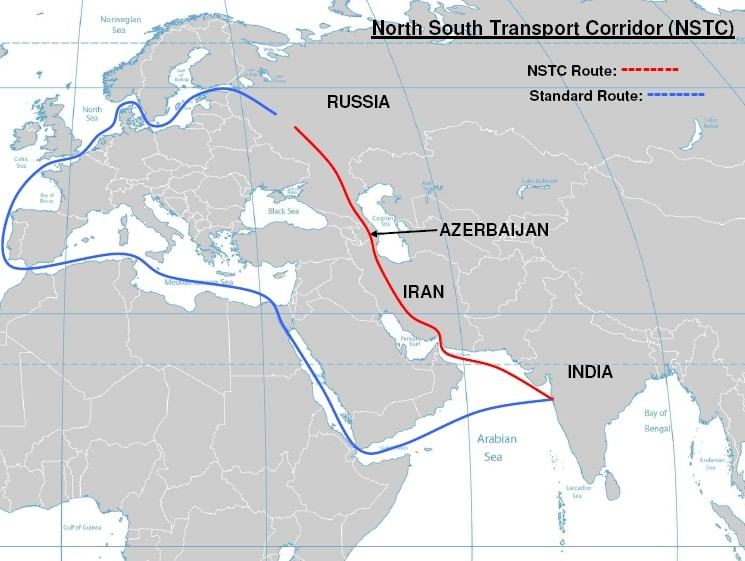Chennai to Vladivostok as India Russia Maritime, Overland Routes Develop
The investment relationship between India and Russia is developing with two Indian ports eyeing trade opportunities at either end of Russia. Both New Delhi and Moscow are looking at creating a key maritime route connecting India with North East Asia and the Western Pacific region via a direct shipping link between Chennai and Vladivostok.
Another planned, mainly overland route extends from shipping originating in Mumbai through to Iran’s Chabahar Port, and overland to European Russia.
The shipping route concept comes following Indian Foreign Minister Sushma Swaraj’s visit to Vladivostok last week to attend the Eastern Economic Forum. India, like China, is looking to expand its presence in Russia’s Far East to harness natural resources there, among them oil and gas supplies as well as diamonds.
India has for centuries been a supplier and center for diamond processing, while the Russian Far East boasts the world’s largest reserves. The Eurasian Diamond Centre opened last month in Vladiviostok; Indian investors have been some of the first to acknowledge the opportunities.
The proposed Chennai-Vladivostok maritime link would enable cargo transfers between Chennai and Vladivostok in 24 days, in comparison to over 40 days currently taken to transport goods from India to Far East Russia via Europe. This proposed maritime route could be transformed into a corridor that would interface with the Indo-Japan Pacific to Indian Ocean Corridor, along China’s own OBOR maritime routes. Taken as a whole, these would connect the entire South East Asian region through road, shipping, and rail links.
Swaraj met Russian Foreign Minister Sergey Lavrov, Industry Minister Denis Manturov, Natural Resources Minister Sergei Donskoi, and Deputy PM and President’s envoy for Far East Yury Trutnev, besides governors of provinces in the region to discuss India’s role. This comes alongside Moscow’s desire to diversify investment options in Russia’s Far East beyond those of China. Moscow has a demographic issue with developing the region; it is under populated and under utilized.
China, meanwhile, has tens of million of workers at its disposal, and Beijing has already made overtures to Moscow to have them lease land from areas in Siberia to make it productive. Moscow’s concerns are whether they would ever get the land back once Chinese settlers have occupied their territory. For this reason it is open to other nationals, including Indians. The future development pattern could change the demographics of Far East Russia, and a growing presence of other countries’ nationals, including Indians, will help to bring balance in this case.
Russia’s Far Eastern Federal District (twice the size of India) is the largest but the least populated of the eight federal districts of Russia, with a population of roughly 6.3 million. India was the first country to establish a resident Consulate in Vladivostok in 1992. Current engagement of India with the region is limited to isolated pockets, such as the Irkut Corporation in Irkutsk where the Mig and Sukhoi aircraft are built, over US$6 billion worth of investments by ONGC Visesh Limited in the Sakhalin 1 project, and recently – the Eurasian Diamond Centre, where the Indian Group KGK, a global leader in gems and jewelry, expects to employ up to 500 people at their new facility to polish and cut Siberian diamonds before releasing them on the international market. KGK have been granted a certificate of residence for the Vladivostok Free Trade Zone, giving them tax and customs preferences, and lower shipping costs.
The Russian Far East region has a wealth of natural resources, including land, timber, mineral, and other resources, such as tin, gold, diamonds, and oil and natural gas. The Russian government has announced several initiatives to attract investments in the region, including an agricultural SEZ, the Vladivostok Free Port Project, and also invites participation in the timber industry, mining of mineral resources (coal and diamonds), and precious metal deposits (gold, platinum, tin, and tungsten). Opportunities for collaboration for Indian companies include such sectors as agriculture, mining, port development and infrastructure, diamond processing, and agro-processing.
India and Russia are also coming together via overland routes, such as the International North-South Transport Corridor, which connects India via Iran and Azerbaijan to Russia and provide access to Europe and Central Asia.
“These new trade routes will have particular impact when India’s Free Trade Agreement with the Eurasian Economic Union is finalized”, says Chris Devonshire-Ellis of Dezan Shira & Associates. “Russia is keen to develop ties with India, it offers a huge consumer market for Russian goods, while the Russians have long enjoyed Indian teas, spices, and fabrics. The move to open up alternative sea routes makes economic and strategic sense for both, and indicates that China is not the only player when it comes to Silk Road developments. The connectivity also secures access to natural resources that are crucial for a growing economy like India, and counterbalances China’s regional influence, and especially in Russia’s Far East.”
Dezan Shira & Associates have offices in Delhi and Mumbai as well as St.Petersburg and Moscow. Interested parties should email either india@dezshira.com or russia@dezshira.com to discuss opportunities in these markets.
About Us
Silk Road Briefing is produced and written by Dezan Shira & Associates. The firm provides governments and corporate businesses worldwide with strategic, legal, tax and operational advisory services to their SMEs and MNCs investing throughout Eurasia and has 28 offices across China, India, Russia and the ASEAN nations, and partner firms in Central Asia. We have specific and long term experience in China and the OBOR countries. For assistance with OBOR related issues, please contact the firm at silkroad@dezshira.com or visit the practice at www.dezshira.com
Related Reading:
![]() Russia Gives Free Land, Incentives to Invest in Asian Far East
Russia Gives Free Land, Incentives to Invest in Asian Far East
Silk Road and OBOR Business Intelligence
Dezan Shira & Associates´ Silk Road and OBOR investment brochure offers an introduction to the region and an overview of the services provided by the firm. It is Dezan Shira´s mission to guide investors through the Silk Road´s complex regulatory environment and assist with all aspects of establishing, maintaining and growing business operations in the region.
Establishing a Foreign Business in Russia
In this issue of Russia Briefing, we explain the basics of business set up for foreign investors, from trademark registration, representation, trading mechanisms, and manufacturing. With low corporate tax rates, Russia is set to become the most dynamic of the trade corridors opening up to Asia.
An Introduction to Doing Business in India 2017
An Introduction to Doing Business in India 2017 is designed to introduce the fundamentals of investing in India. As such, this comprehensive guide is ideal not only for businesses looking to enter the Indian market, but also for companies who already have a presence here and want to stay up-to-date with the most recent and relevant policy changes.










